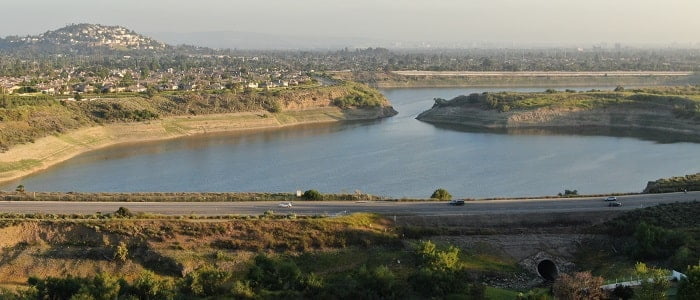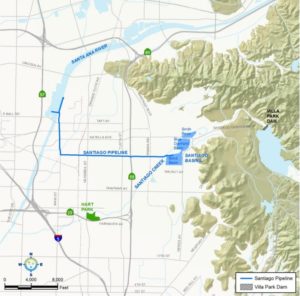The Santiago Basin is located downstream of Villa Park Dam in Cities of Orange and Villa Park. There are in fact three basins comprised of Blue Diamond Basin (Orange), Bond Basin (Orange), and Smith Basin (Villa Park). The reservoirs are recharge basins owned and operated by The Orange County Water District (OCWD). The water comes from storm water collected by Santiago Creek and the Santa Ana River. The recharge basins are used to manage stormwater runoff, prevent flooding and downstream erosion. However, the OCWD also seeks to recharge as much water as possible in the Santiago Basins.
The reservoir is used to percolate water into the groundwater basin, where it becomes a drinking-water supply for Central and North Orange County. After it percolates through sand, the water is shipped to water distributors; some of them further filter the water and some do not. These former gravel pits contain a large percentage of the storage capacity within the OCWD’s recharge system.
The OCWD continually seeks to expand the basin’s annual yield by maximizing the amount of water recharged into the basin, developing new sources of water to recharge the basin, and increasing the effectiveness of the District’s facilities.
The basin also operates as a flood protection facility though it generally remains full year round as a scenic lake. The vertical edges of the basin and loose soils preclude public access to the water. Clusters of native southern California plant communities thrive along the edges of the reservoir.

Why the Santiago Basin Water Levels Change
The basins are pumped down in the summer and fall months in order to create storage for winter rains and storm-water capture.
What is the Official Name of the Basins?
The OCWD refers to the basins as Santiago Basins with each basin named Blue Diamond Basin, Bond Basin, and Smith Basin. Smith is the northern most basin above Villa Park Rd, Blue Diamond is in the middle south of Villa Park Rd and Bond is the southernmost basin located off Hewes and Bond streets.
Other names for the basin has been called are Santiago Creek Recharge Basin, Santiago Creek Basin, Santiago Reservoir, Villa Park Reservoir, Villa Park Basin and Orange Basin. Most other sites, including Google Maps, list the basin as Santiago Creek Recharge Basin.
About Villa Park Drinking Water
The Villa Park drinking water is a blend of local native surface water and imported Metropolitan Water District (MWD) water impounded within Santiago Reservoir. Additionally, groundwater is pumped from the local aquifer managed by OCWD that stretches from the Prado Dam and fans across the north western portion of Orange County, excluding the communities of Brea and La Habra, and stretching as far south as El Toro.
Santiago Basin History
The Santiago Basin are former 365 acre sand and gravel pits which were purchased by OCWD in 1883 and the early 1990s. Prior to the early 1990s, the only source of water to Santiago Basins was runoff from Santiago Creek. In the early 1990s, the Burris Basin Pump Station and Santiago Pipeline were constructed, allowing Santa Ana River water to be pumped to Santiago Basins for recharge. Pumped water can also be diverted to the creek downstream of the basins for recharge.
The area was first developed in the 1870s when Oge and Bond formed the Oge-Bond Tract. The Bond name is prevalent in the area with one basin named Bond basin and the Bond St which borders the basin.
1983
OCWD purchased two sand and gravel pits along Santiago Creek for additional recharge capacity.
1991
Santiago Creek recharge project is completed, including purchase and development of Santiago Basins along Santiago Creek, a pump station at Burris Basin, and a pipeline to convey water back and forth from recharge basins along the Santa Ana River and Santiago Basins. Two rubber dams are installed on the Santa Ana River, allowing for more efficient diversion of river water to the downstream recharge facilities. The increased capture of water from the dams paid for the cost of the dams within the first year of operation.
2003
Santiago Basin Pump Station
An underwater pump station was installed in Bond basin to increase recharge capacity. With completion of the Santiago Basin Pump Station in 2003, OCWD enabled the capacity to move water both directions in the Santiago Pipeline. This allowed for faster draining of the Santiago Basins, freeing up storage for stormwater capture and increasing the District’s recharge capacity. During average rainfall conditions, the District captures and recharges an estimated 50,000 to 70,000 afy of storm flow, with much of this recharge taking place in the Santiago Basins.
2012
Santiago Basin Floating Pump Station
The underwater pump station presented some problems and was replaced by a floating pump station. The floating pump station was constructed in 2012 to dewater the Santiago Basins to increase storm flow capture and percolation, to make storage available for winter season use, to provide water to the Santiago Creek for percolation, and to allow for the transfer of stored water from the Santiago Basins to other OCWD facilities. Operation of the pump station for the basins increased recharge capacity and allowed for more flexible and efficient operations. Butier Engineering, Inc. constructed the floating pump station.
Wildlife at the Santiago Creek Reservoir
There are many animals to be found in and around the reservoirs and some that might surprise you such as mountain lions, bobcats and deer. For a detailed list of sightings check out inaturalist.org.
There are also hundreds of different birds around the Santiago Basin including turkey vultures, doves, hawks, hummingbirds, woodpeckers, egrets, herons, sparrows and quail.
One of those birds, the Western Grebe that eats fish and attempts to nest in remote OCWD basin nooks. These birds are black and white with a 2-foot wingspan and a croaky trumpeting call that echoes across the Santiago Basins in spring. Mated pairs perform a “Rushing Ceremony” that you can watch on YouTube, with arched necks they run on the water side-by-side, then dive, and mate. They attempt to nest in partly submerged tree limbs along an inlet that passes water from the basin to Santiago Creek during high water conditions. Those conditions generally don’t last long enough, and nests fail.
Another bird is the threatened California gnatcatcher in the shrublands around the Santiago basins. These little birds eat insects, nest in California sagebrush, and give a call easily mistaken for the meow of a kitten. They are entirely dependent upon rainfall; if it doesn’t rain, plant and insect production are poor and the year-round resident birds suffer.
For a detailed list of sightings check out ebird.org.
There is no fishing allowed in the Santiago Reservoirs which doesn’t mean that people don’t ninja in there and fish the reservoir. Reported fish being caught there are bass, trout, carp and bluegill. Also, look out for the slider turtles in the waters.
How to view the Santiago Basin?
The Santiago Creek Bike Trail (SCBT) has viewing windows through the walls on the trail on Hewes St and Bond St. The SCBT Cannon St staging area also has views. Driving on Villa Park Rd between the reservoirs provides views and lastly many Orange and Villa Park homes provide excellent views.
Orange County Groundwater Basins
The groundwater basins managed by OCWD supplies 75% of the water needs to more than 2 million residents in the cities of Anaheim, Buena Park, Cypress, Costa Mesa, Fountain Valley, Fullerton, Garden Grove, Huntington Beach, Irvine, La Palma, Los Alamitos, Newport Beach, Orange, Placentia, Santa Ana, Seal Beach, Stanton, Tustin, Villa Park, Westminster and Yorba Linda.
About 200 million gallons per day of wastewater, from more than 2.5 million customers, is sent to the Orange County Sanitation District (OCSD), where it is treated. Some of the treated wastewater is discharged into the Pacific Ocean, but about 130 million gallons of it is sent to OCWD’s Groundwater Replenishment System (GWRS) where it is purified to exceed drinking water standards. The GWRS water is then put back into the basin where it blends with all the other water supplies and is ultimately reused again, and again and again.
OCWD owns 2,150 acres of land in Riverside County. Nearly 465 acres of the land behind Prado Dam are constructed wetlands. One-half of Santa Ana River flows are routed through the wetlands to naturally remove nitrates and other contaminants in the water. In addition to improving water quality, OCWD’s wetlands provide an opportunity for native habitat to thrive.
